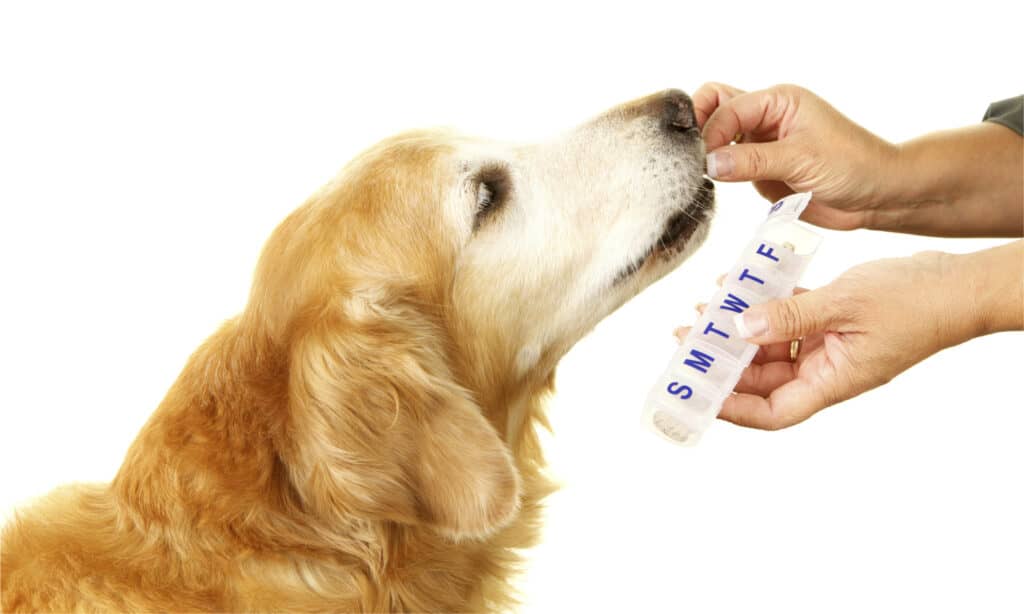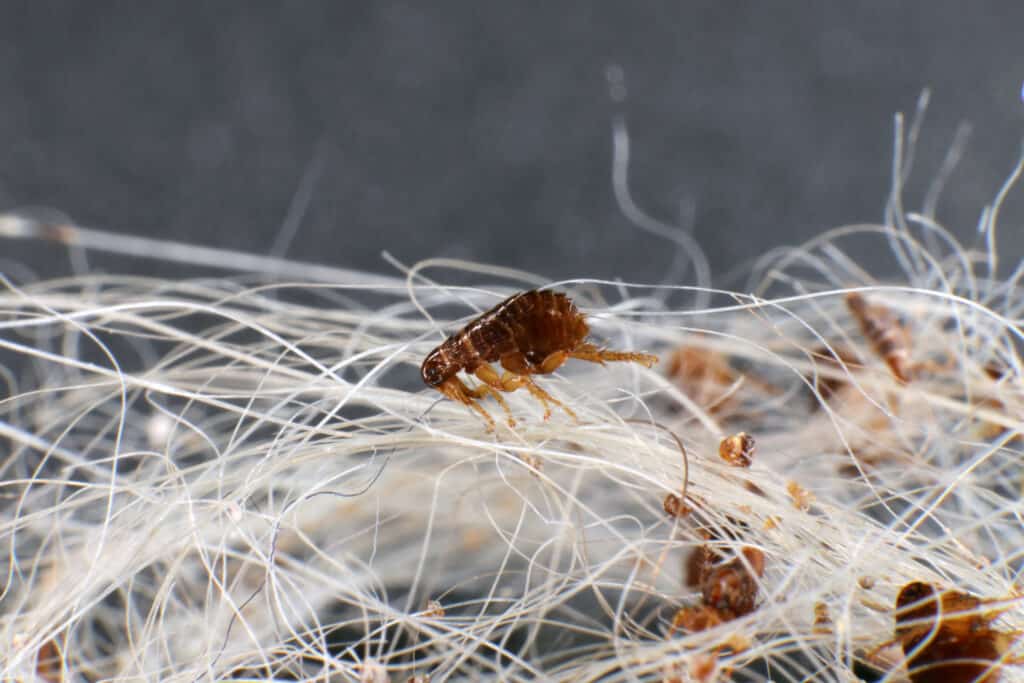Has your vet prescribed Bravecto to prevent fleas and ticks in your dog? You likely have a list of questions about what this medication is and how it works, so let’s discuss everything you need to know about Bravecto for dogs below!
What Is Bravecto?

Bravecto is a medication used to treat and prevent fleas, ticks, and skin mites in dogs.
©Donna Ellen Coleman/Shutterstock.com
Bravecto is a medication that is used to treat and prevent ectoparasites in dogs. Ectoparasites refers to any parasites that live on the surface of your dog’s skin, including fleas, ticks, and skin mites. The main ingredient in Bravecto is an agent called fluralaner.
Fluralaner is distributed throughout the dog’s body and into their bloodstream when oral Bravecto is given, so when fleas or ticks bite your dog’s skin in search of blood to feed on, they are exposed to the fluralaner. A similar process occurs when giving your dog the topical form of Bravecto, only the fluralaner deposits just under the dog’s skin. Fleas die within 8 hours of biting the treated dog, and ticks die within 12-48 hours of biting the treated dog.
Oral Bravecto is also used to treat active skin mite infections. Bravecto will clear ear mites and sarcoptic mange within 1 month, and demodectic mange within 2 months. However, Bravecto cannot treat any skin infections as a result of skin mites, so your pup may still need a round of antibiotics if they have develop a significant skin infection.
Is Bravecto Safe For Dogs?
Pet parents have become weary of flea and tick medication over the last few years due to circulating misinformation on the topic. While side effects are always possible in a small percentage of dogs using any medication, most flea and tick preventions are generally safe when following the dosing instructions your vet offers. This applies to Bravecto usage as well when given in healthy dogs.
Studies show that Bravecto is generally safe for dogs, and it has a wide safety margin. This study shows that Bravecto has a safety margin of more than five, which means dogs can tolerate five times their recommended dose before developing any health complications. Another study shows that Bravecto is even well tolerated in dogs with a genetic mutation that makes them sensitive to some flea and tick products. This genetic mutation is most common in Border Collies.
Ultimately, Bravecto is a safe medication that many vets feel comfortable prescribing to dogs. Oral Bravecto can be prescribed to dogs over eight weeks of age, and topical Bravecto can be prescribed to dogs six months and older.
Why Do Dogs Take Bravecto?

Fleas are an irritating ectoparasite that can cause severe skin irritation and secondary skin infections.
©photowind/Shutterstock.com
Bravecto is a medication used to treat and prevent fleas, ticks, and skin mites in dogs. Let’s break down the importance of treating each of these ectoparasites!
Fleas: Fleas are a tiny ectoparasite that survive by feeding on the blood of their host. Not only are the flea bites irritating in themselves, but the sensation of fleas crawling on the skin can cause significant itching as well. Dogs with fleas may experience itchy skin, skin redness, dry skin, fur loss, and sores on the skin. Severe flea burdens can also lead to anemia.
Ticks: Ticks are another ectoparasite that feed on the blood of their hosts. Not only can a large tick burden cause anemia in dogs, but ticks can infect your dog with dangerous tick disease. Some of the most common tick diseases seen in dogs include anaplasmosis, ehrlichiosis, Lyme disease, babesiosis, and Rocky Mountain spotted fever.
Skin mites: Skin mites are microscopic ectoparasites that live within the dog’s hair follicles. These mites can cause significant skin irritation and fur loss, often leading to subsequent skin infections. A severe skin mite infection can also lead to systemic health complications in some dogs.
Amy Nicole Lewis, a veterinarian with Worldwide Veterinary Services told A-Z Animals that ectoparasites are much more than just an irritating critter living on your dog’s skin. Ectoparasites can cause skin infections, spread fatal illnesses, and impact your dog’s overall health. Flea and tick prevention is essential for your dog’s ongoing health and happiness.
How To Give Bravecto To Dogs
There are two forms of Bravecto for dogs, so let’s break down how to give each form in detail below!
Oral Bravecto: Oral Bravecto comes in a chewable tablet that many dogs love. Oral Bravecto should be given by mouth every 12 weeks, and it can be given with or without food.
Topical Bravecto: Topical Bravecto should be applied directly to the skin, in between your dog’s shoulder blades every 12 weeks. Applying the medication between the shoulder blades prevents your dog from licking the medication.
What Is The Dose Of Bravecto In Dogs?
Bravecto comes in five different dosages that are suitable for dogs of different sizes, ranging from 4.4 pounds to 123 pounds. Each chewable or topical form of Bravecto is created to offer 11.4 mg per pound of body weight.
Each package of Bravecto will display the weight range the dose is intended for, so all you need to do is find the package that lists your dog’s weight. If your dog falls outside of the 4.4-123 pound weight range, we suggest reaching out to your vet for dosing guidance.
Are There Any Side Effects Of Bravecto Use In Dogs?
Bravecto is considered a safe flea and tick prevention for dogs, but there are a few side effects you should be on the lookout for. Some dogs have developed vomiting and lethargy when taking the oral form of Bravecto, but most of their symptoms resolved within 24-48 hours. Some dogs have develop local skin irritation and hair loss when taking the topical form of Bravecto, but this often resolves quickly and without issue as well.
We suggest reaching out to your vet if your dog develops any of the above side effects to be safe. It is rare for dogs to develop severe side effects after Bravecto use, but it’s always best to keep your vet in the loop.
How Do I Get Bravecto For My Dog?
Bravecto is a form of flea and tick prevention that can only be found at your vet’s office, or purchased at a pet store with a prescription from your vet. We suggest reaching out to your veterinary team if you think your dog can benefit from the use of oral or topical Bravecto!
The photo featured at the top of this post is © New Africa/Shutterstock.com
Ready to discover the top 10 cutest dog breeds in the entire world?
How about the fastest dogs, the largest dogs and those that are -- quite frankly -- just the kindest dogs on the planet? Each day, AZ Animals sends out lists just like this to our thousands of email subscribers. And the best part? It's FREE. Join today by entering your email below.
Thank you for reading! Have some feedback for us? Contact the AZ Animals editorial team.






